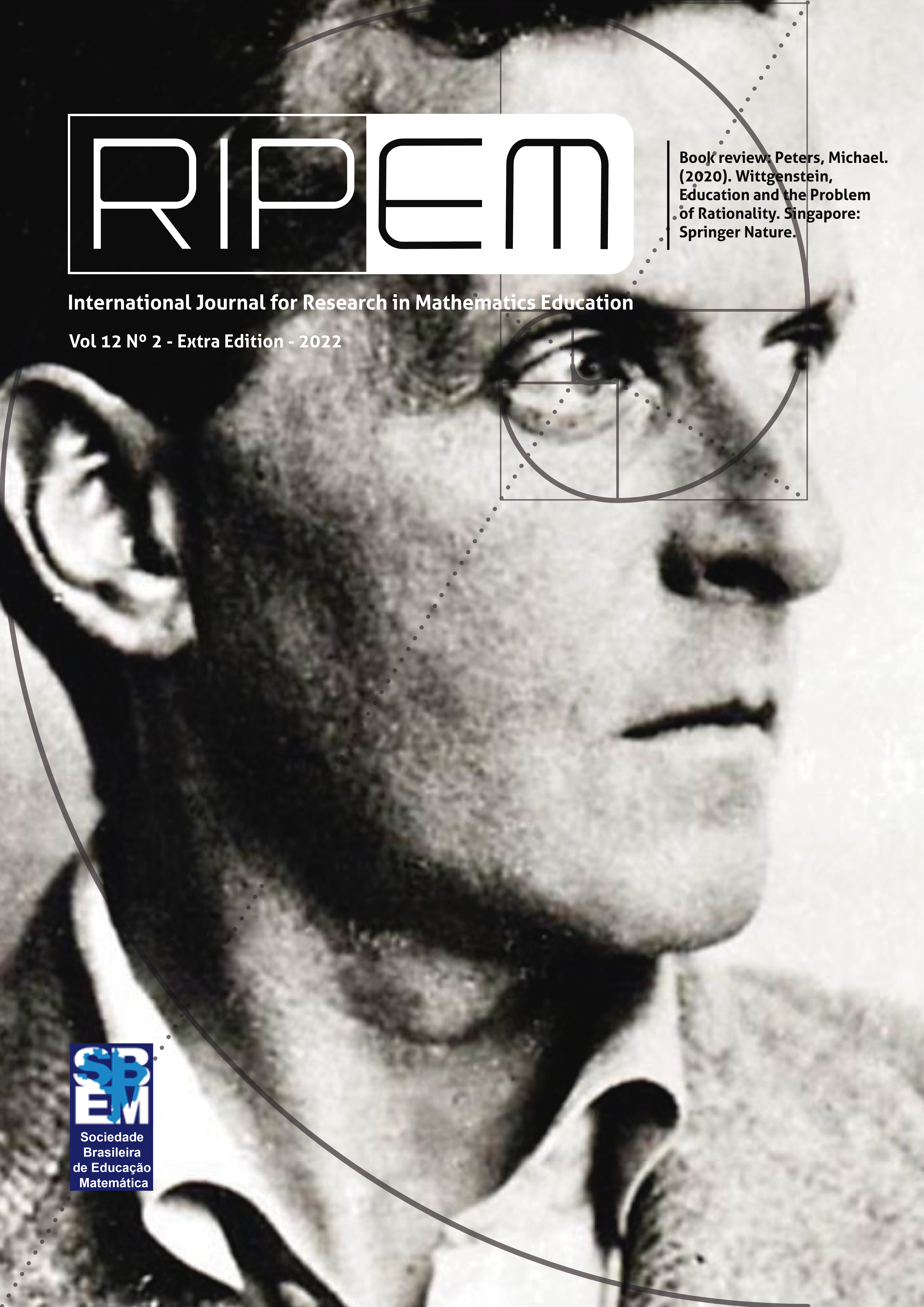Isometries: epistemological insights among secondary students interacting in Dynamic Geometric environment with touches on screen
DOI:
https://doi.org/10.37001/ripem.v12i2.2834Palavras-chave:
Isometry, Task-Design, GeoGebra APP, TouchResumo
This study investigates secondary students’ understanding of isometry (symmetry, rotation and translations) using dynamic geometry environment with touchscreen (DGEwT). The research question addresses issues concerning geometrical reasoning of Brazilian learners without previous knowledge regarding isometry. Data came from videotapes, written notes for each proposed task and on the icon sheet, and from screen recording. The analytical process was mainly based on the geometrical reasoning and related procedures. One designed task is shown and analyzed. Applying reflectional symmetry ideas, using procedures based on straight line and performing simultaneous touches on the screen, students achieved the composition of rotation and translation movement naturally and synchronically. The study highlighted the relevance of isometry in both school and teacher training curriculum.
Downloads
Referências
Arzarello, F. et al. A cognitive analysis of dragging practises in Cabri environments. Zentralblatt für Didaktik der Mathematik, 34(3), 66-72.
Arzarello, F. (2006). Semiosis as a multimodal process. Revista Latinoamericana de Investigación en Matemática Educativa RELIME, v. 9, n. Extraordinario 1, 267-299.
Arzarello, F., Bairral, M., & Dané, C. (2014). Moving from dragging to touchscreen: geometrical learning with geometric dynamic software. Teaching Mathematics and its Applications, 33(1), 39-51.
Assis, R. de A. (2016). Alunos do Ensino Médio trabalhando no GeoGebra e no Geometric Constructor: mãos e rotAções em touchscreen. Master dissertation, Federal Rural University of Rio de Janeiro. Brazil.
Assis, A., & Bairral, M. (2019). Using touchscreen devices to improve plane transformation in high school classroom International Journal for Research in Mathematics Education (RIPEM), 9(1), 45-60.
Assis, A. R. de (2017). Transformações isométricas com manipulações em tela. Boletim Gepem(70), 186-197.
Assis, A. R. de (2020). Alunos do Ensino Médio realizando toques em telas e aplicando isometrias com GeoGebra. Doctoral dissertation, Federal Rural University of Rio de Janeiro. Brazil.
Bairral, M. (2017). Toques en pantalla y transformaciones planas. Uno. Revista de Didáctica de las Matemáticas (77), 46-50.
Bairral, M. (2019). Dimensions to Be Considered in Teaching, Learning and Research with Mobile Devices with Touchscreen. Acta Scientiae, 21(2), 93-109.
Bairral, M. (2020). Not Only What is Written Counts! Touchscreen Enhancing Our Cognition and Language. Global Journal of Human-Social Science (G), 20(5), 1-10.
Bairral, M., Arzarello, F., & Assis, A. (2017). Domains of manipulation in touchscreen devices and some didactic, cognitive and epistemological implications for improving geometric thinking. In G. Aldon, F. Hitt, L. Bazzini, & U. Gellert (Eds.), Mathematics and technology: a C.I.E.A.E.M source book (pp. 113-142). Hamburg, Germany: Springer.
Bairral, M., Henrique, M. P., & Assis, A. (2022). Moving Parallel and Transversal Lines with Touches on Smartphones: A Look through Screenrecording. The Mathematics Enthusiast (TME), 19(1), 113-135.
Bairral, M., Assis, A., Silva, B. C. (2015). Mãos em ação em dispositivos touchscreen na educação matemática. EDUR.
Berisha, V., Gimenez, J., & Thaqi, X. (2013). Using geometrical transformations in the primary mathematics textbooks in Kosova and Catalonia. Paper presented at the CERME 8.
Bolite Frant, J. (2002). Corpo e tecnologia: Implicações para cognição matemática. (2002).
Delmondi, N. N., & Pazuch, V. (2018). Um panorama teórico das tendências de pesquisa sobre o ensino de transformações geométricas. RBEP, 99(253), 659-686.
Hollebrands, K. (2003). High school students’ understandings of geometric transformations in the context of a technological environment Journal of Mathematical Behavior, 22(52-72).
Kruger, R., Carpendale, S., Scott, S. D., & Tang, A. (2005). Fluid Integration of Rotation and Translation. Paper presented at the Proceedings of the ACM Conference on Human Factors in Computing Systems (CHI)'05, April 2-7, 2005, Portland, Oregon, USA, pp. 601-610.
Moore-Russo, D., & Viglietti, J. M. (2014). Embodied cognition across dimensions of gestures. Considering Teachers' responses to Three-Dimensional Tasks. In L. Edwards, F. Ferrara, & D. Moore-Russo (Eds.), Emerging perspectives on gesture and embodiment in mathematics (pp. 137-227). New York: Information Age Publishing.
Ng, O., & Sinclair, N. (2015). Young children reasoning about symmetry in a dynamic geometry environment. ZDM Mathematics, 47(3), 421–434.
Paulo, R. M., Pereira, A. L., & Pavanelo, E. (2020). The constitution of mathematical knowledge with augmented reality. The Mathematics Enthusiast (TME), 18(3), 640-668.
Radford, L. (2014). Towards an embodied, cultural, and material conception of mathematics cognition. ZDM – The international journal on Mathematics Education, 46(3), 349-361.
Rosa, M., Farsani, D., & Silva, C. (2020). Mathematics education, body and digital games: The perception of body-proper opening up horizons of mathematical knowledge constitution. Mathematics Teaching Research Journal. 12 (2), 310-324.
Silva, C. V., & Almouloud, A. S. (2021). Um estudo histórico e epistemológico sobre o objeto matemático Simetria Ortogonal. Intermaths, 2(1), 71-87.
Tang, A., Pahud, M., Carpendale, S., & Buxton, B. (2010). VisTACO: Visualizing Tabletop Collaboration. International Conference on Interactive Tabletops and Surfaces (ITS '10). Paper presented at the International Conference on Interactive Tabletops and Surfaces (ITS '10), Saarbrücken,Germany.
Veloso, E. (2012). Simetria e transformações geométricas. Lisboa: APM.
Publicado
Como Citar
Edição
Seção

Este trabalho está licensiado sob uma licença Creative Commons Attribution-NonCommercial-NoDerivatives 4.0 International License.








